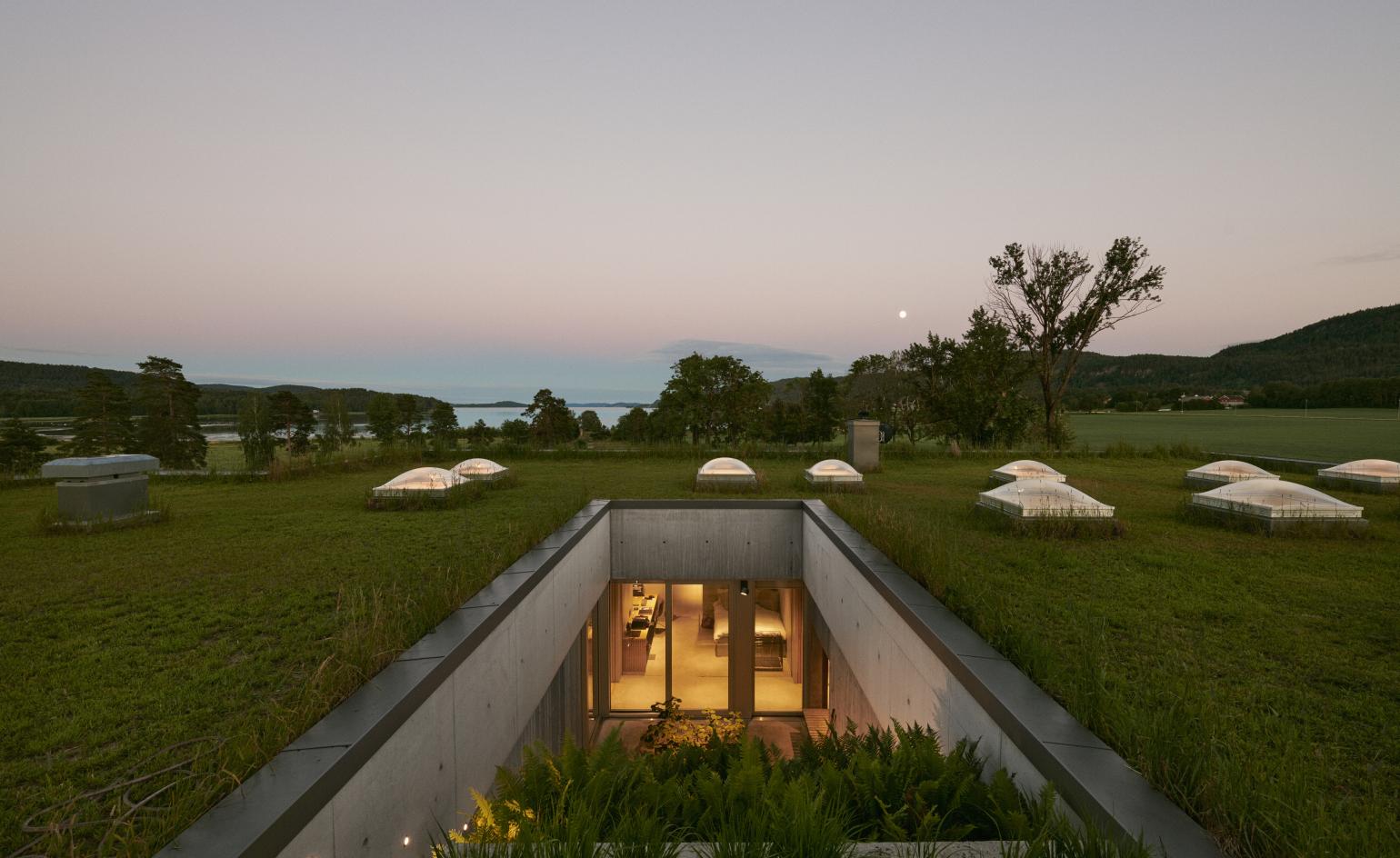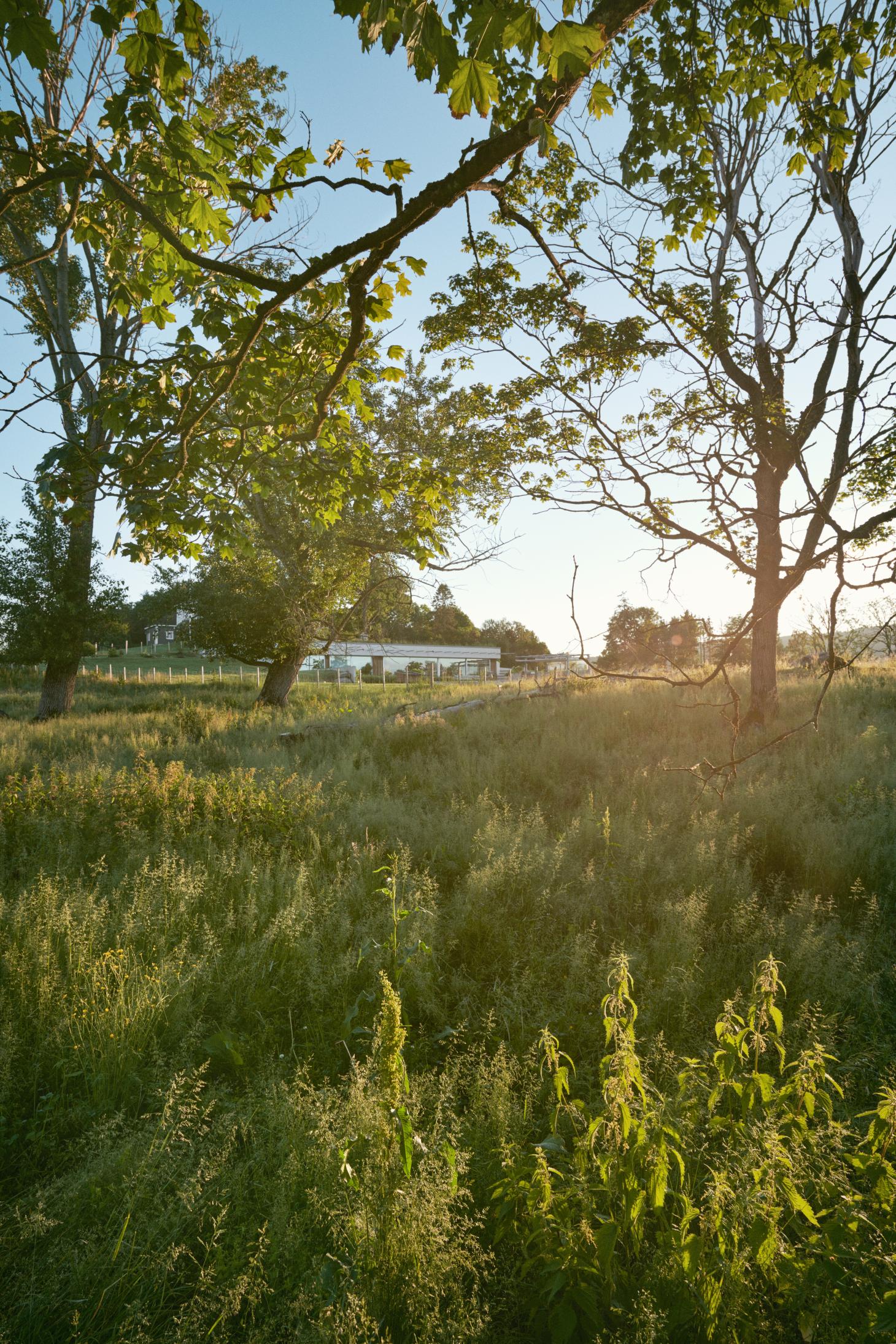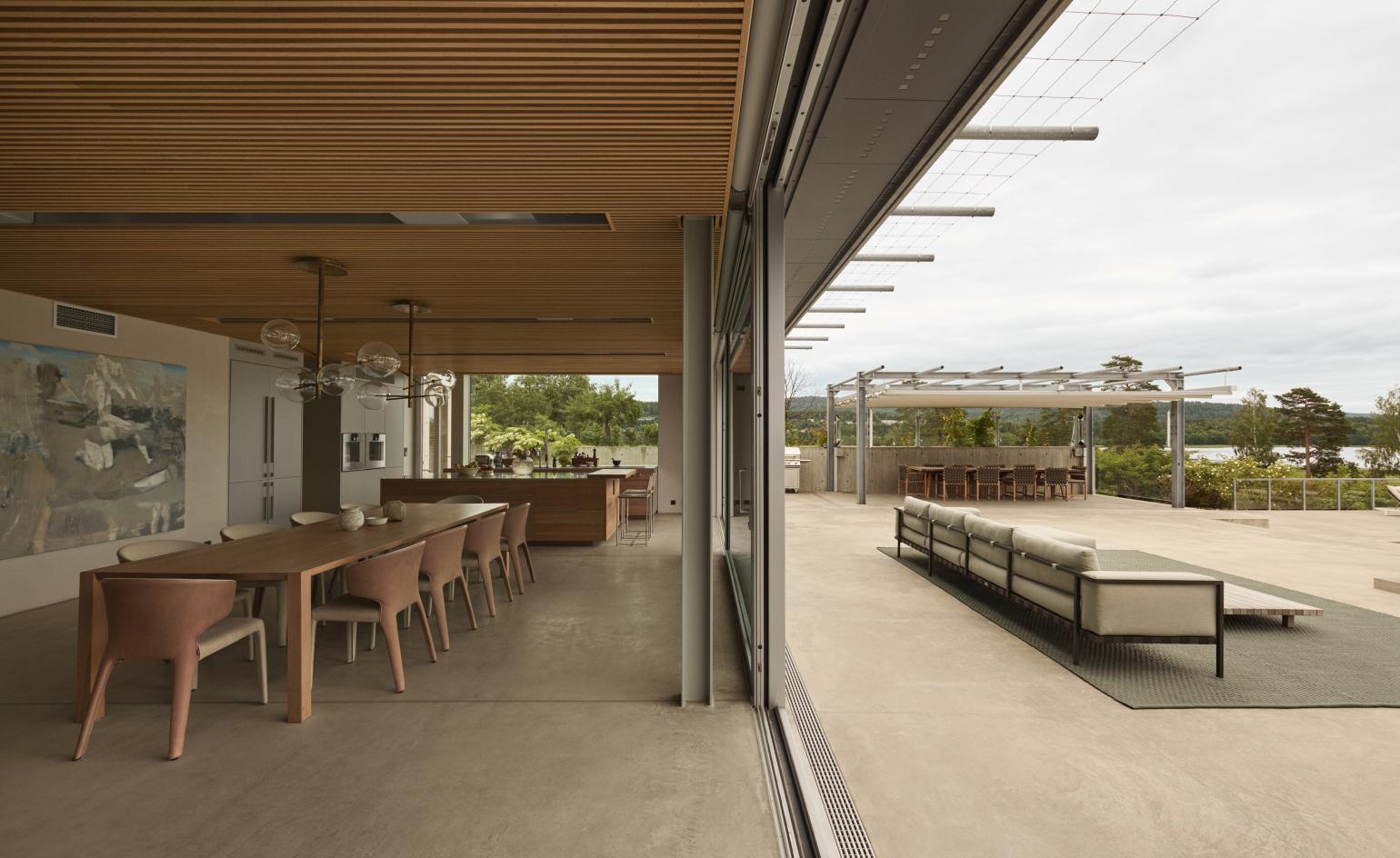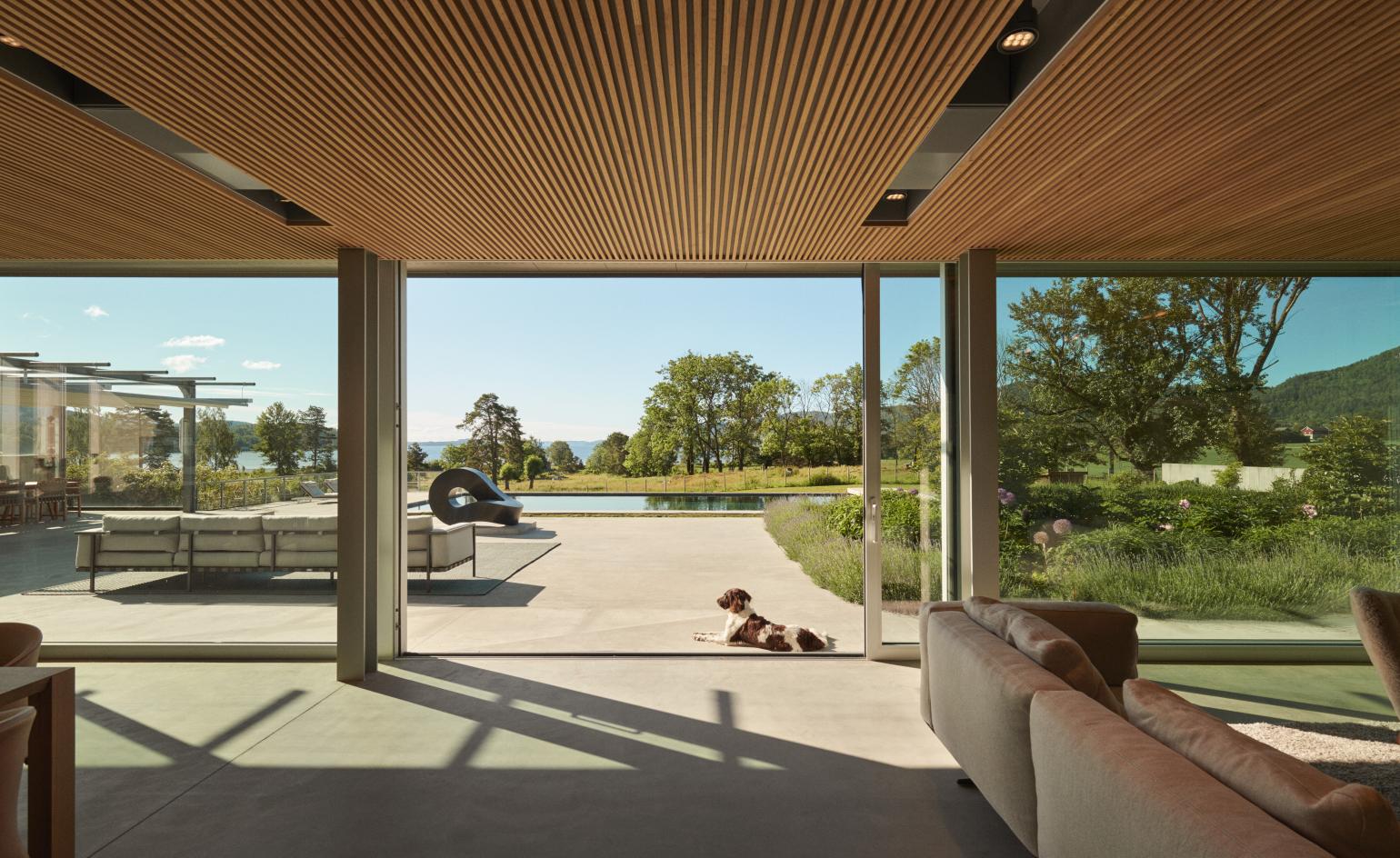Invisible house in Norway peeks out from its green setting
CF Møller Architects designs Villa Aa, a discreet, near-invisible house in the countryside of Norway, built to respect the surrounding nature and historic farmland of Vestfold

Ivar Kvaal - Photography
Danish architecture practice CF Møller has created an invisible house. Villa Aa, located among the rolling hills and historic farmhouses of the Norwegian countryside, is thoroughly modern, yet seemingly melts into its context of greenery and water in the region of Vestfold. Remaining discreet and avoiding any architectural gestures that would make the house prominently stand out in its setting was a key objective right from the start of the development of this elegant, yet minimalist and subtle family home.
Set within historic farmland, as a new addition to an existing farming complex, the design negotiates its impact on the pristine natural surroundings with poise. In order to protect views, biodiversity and the wider landscape, Villa Aa is nestled into a slope, partly buried and partly completely open to long views of the fields and water beyond. A green roof, carefully chosen materials, and a low overall volume ensure the architecture seamlessly embeds itself into the site.
At the same time, ‘large parts of the southern façade are covered with glass, which provides good lighting conditions, opportunities for natural ventilation and a fantastic view of the fjord', the architects explain.
Invisible house: low profile, low impact

The home’s main living space, an expansive open-plan area that flows from kitchen to dining space and lounge, is naturally orientated towards the views. Tucked away towards the rear is a more informal family room, as well as bedrooms and bathrooms. Apart from the usual domestic areas, the generous residence also includes a foyer with space for a small glass display case showing family heirlooms, a home office, a guest room, and a utility room.
Concrete is used throughout – selected for its durability, given that this remains a working farm. It dominates the interiors and the exterior landscaping, such as terraces and steps. Visible formwork and white cement and aggregate afford a tactile and light feel. Untreated cedar cladding, pre-patinated zinc and steel create accents and add texture, while swathes of glass on the front façade make it all appear lightweight and translucent.
Outdoor areas here are just as important as the indoors, with a wide range of external living spaces surrounding the property. There is a curated garden by Dronninga Landskap; a selection of sun terraces, featuring sculptures and a pergola; and a strong water presence, including a swimming pool and two water mirrors, softening the hard surfaces of the complex. One of the water elements is richly populated by aquatic plants, highlighting how nature and architecture come together effortlessly in this clever, invisible house.






INFORMATION
Wallpaper* Newsletter
Receive our daily digest of inspiration, escapism and design stories from around the world direct to your inbox.
Ellie Stathaki is the Architecture & Environment Director at Wallpaper*. She trained as an architect at the Aristotle University of Thessaloniki in Greece and studied architectural history at the Bartlett in London. Now an established journalist, she has been a member of the Wallpaper* team since 2006, visiting buildings across the globe and interviewing leading architects such as Tadao Ando and Rem Koolhaas. Ellie has also taken part in judging panels, moderated events, curated shows and contributed in books, such as The Contemporary House (Thames & Hudson, 2018), Glenn Sestig Architecture Diary (2020) and House London (2022).
-
 Sotheby’s is auctioning a rare Frank Lloyd Wright lamp – and it could fetch $5 million
Sotheby’s is auctioning a rare Frank Lloyd Wright lamp – and it could fetch $5 millionThe architect's ‘Double-Pedestal’ lamp, which was designed for the Dana House in 1903, is hitting the auction block 13 May at Sotheby's.
By Anna Solomon
-
 Naoto Fukasawa sparks children’s imaginations with play sculptures
Naoto Fukasawa sparks children’s imaginations with play sculpturesThe Japanese designer creates an intuitive series of bold play sculptures, designed to spark children’s desire to play without thinking
By Danielle Demetriou
-
 Japan in Milan! See the highlights of Japanese design at Milan Design Week 2025
Japan in Milan! See the highlights of Japanese design at Milan Design Week 2025At Milan Design Week 2025 Japanese craftsmanship was a front runner with an array of projects in the spotlight. Here are some of our highlights
By Danielle Demetriou
-
 Step inside Rains’ headquarters, a streamlined hub for Danish creativity
Step inside Rains’ headquarters, a streamlined hub for Danish creativityDanish lifestyle brand Rains’ new HQ is a vast brutalist construction with a clear-cut approach
By Natasha Levy
-
 PoMo Museum opens its colourful spaces in Trondheim’s art nouveau post office
PoMo Museum opens its colourful spaces in Trondheim’s art nouveau post officePoMo Museum is a new Trondheim art destination, featuring colourful interiors by India Mahdavi in an art nouveau post office heritage building
By Francesca Perry
-
 This restored Danish country home is a celebration of woodworking – and you can book a stay
This restored Danish country home is a celebration of woodworking – and you can book a stayDinesen Country Home has been restored to celebrate its dominant material - timber - and the craft of woodworking; now, you can stay there too
By Ellie Stathaki
-
 Greenland through the eyes of Arctic architects Biosis: 'a breathtaking and challenging environment'
Greenland through the eyes of Arctic architects Biosis: 'a breathtaking and challenging environment'Danish architecture studio Biosis has long worked in Greenland, challenged by its extreme climate and attracted by its Arctic land, people and opportunity; here, founders Morten Vedelsbøl and Mikkel Thams Olsen discuss their experience in the northern territory
By Ellie Stathaki
-
 The Living Places experiment: how can architecture foster future wellbeing?
The Living Places experiment: how can architecture foster future wellbeing?Research initiative Living Places Copenhagen tests ideas around internal comfort and sustainable architecture standards to push the envelope on how contemporary homes and cities can be designed with wellness at their heart
By Ellie Stathaki
-
 Denmark’s BIG has shaped itself the ultimate studio on the quayside in Copenhagen
Denmark’s BIG has shaped itself the ultimate studio on the quayside in CopenhagenBjarke Ingels’ studio BIG has practised what it preaches with a visually sophisticated, low-energy office with playful architectural touches
By Jonathan Bell
-
 Tour this waterfront Norwegian summer house in pristine nature
Tour this waterfront Norwegian summer house in pristine natureCabin Lillesand by architect, Lund Hagem respects and enhances its natural setting in the country's south
By Ellie Stathaki
-
 Wallpaper* Architects’ Directory 2024: meet the practices
Wallpaper* Architects’ Directory 2024: meet the practicesIn the Wallpaper* Architects Directory 2024, our latest guide to exciting, emerging practices from around the world, 20 young studios show off their projects and passion
By Ellie Stathaki